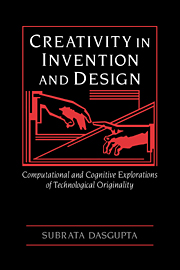Book contents
- Frontmatter
- Contents
- Preface
- Acknowledgments
- Part I Creativity in invention and design: issues and ingredients
- 1 Creativity, invention, and the computational metaphor
- 2 A computational theory of scientific creativity
- 3 Maurice Wilkes and the origins of microprogramming: the historical setting
- Part II The invention of microprogramming: a cognitive explanation
- Part III Reflections on the nature of inventing
- Appendix
- References
- Index
3 - Maurice Wilkes and the origins of microprogramming: the historical setting
Published online by Cambridge University Press: 23 December 2009
- Frontmatter
- Contents
- Preface
- Acknowledgments
- Part I Creativity in invention and design: issues and ingredients
- 1 Creativity, invention, and the computational metaphor
- 2 A computational theory of scientific creativity
- 3 Maurice Wilkes and the origins of microprogramming: the historical setting
- Part II The invention of microprogramming: a cognitive explanation
- Part III Reflections on the nature of inventing
- Appendix
- References
- Index
Summary
In May 1949, the EDSAC computer, designed and constructed by Maurice Wilkes and his co-workers at the Cambridge University Mathematical Laboratory successfully performed its first, fully automatic computation (Wilkes, 1956, p. 39; 1985, p. 142; Wilkes and Renwick 1949). The machine was demonstrated soon after, in June 1949, at a conference entitled “High Speed Automatic Calculating Machines” held in Cambridge during which tables of squares and primes were printed out (Worsley 1949). As noted in chapter 1 (see the section “The invention of microprogramming: as a case study”), the EDSAC was the very first stored program computer to become fully operational.
The EDSAC was a serial machine in that (1) reading from or writing into main memory was done in a “bit-serial” manner – that is, each bit of a memory word was read or written into one at a time, and (2) the arithmetic unit performed its various operations in a bit-by-bit manner.
Soon after the EDSAC's completion, Wilkes became preoccupied with the issues of regularity and complexity in computer design. This preoccupation is documented not only in his retrospective writings (Wilkes 1985, pp. 184–5, 1986), but also in the early sections of Wilkes (1951), as a preamble to his description of the microprogramming principle. Thus, there is considerable evidence that the development of microprogramming was the outcome of the following problem:
To design a control unit that would be systematic and regular in structure in much the same way that the memory unit is regular in structure.
- Type
- Chapter
- Information
- Creativity in Invention and Design , pp. 65 - 88Publisher: Cambridge University PressPrint publication year: 1994



